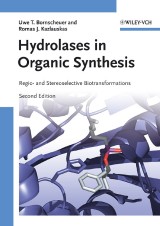Details
Hydrolases in Organic Synthesis
Regio- and Stereoselective Biotransformations2. Aufl.
|
138,99 € |
|
| Verlag: | Wiley-Blackwell (WB) |
| Format: | |
| Veröffentl.: | 12.05.2006 |
| ISBN/EAN: | 9783527607129 |
| Sprache: | englisch |
| Anzahl Seiten: | 368 |
DRM-geschütztes eBook, Sie benötigen z.B. Adobe Digital Editions und eine Adobe ID zum Lesen.
Beschreibungen
From reviews to the first edtion:<br> <br> "Bornscheuer and Kazlauskas have set out, and succeeded, in producing a definitive manual on hydrolytic enzymes (especially lipases, esterases, and proteases) for organic chemists. This is quite simply the best book of its type and can be unreservedly recommended to organic chemists who have an interest in using hydrolytic enzymes in synthesis." (Nicholas J. Turner, University of Edinburgh)<br> <br> "The book is an indispensable source of information on the use of hydrolases in organic synthesis. The subject matter is very well set out, and the chapters are clearly written and presented from a critical viewpoint. Bornscheuer and Kazlauskas have succeeded admirably in describing the capabilities and limitations of the use of hydrolytic enzymes and in critically evaluating them. No library should be without the book." (Fritz Theil, WITEGA Angewandte Werkstoff-Forschung GmbH, Berlin)<br> <br> The second edition of this extremely successful and well-proven book presents recent developments in the use of hydrolases for organic synthesis, reflecting in particular the enormous progress made in enzyme discovery and optimization with a new chapter on "Protein Sources and Optimization of Biocatalyst Performance". <br> The renowned authors survey the stereoselective reactions of hydrolases, especially lipases, esterases and proteases, giving researchers an overview of what has worked in the past so that they can judge how to solve their own synthetic problems. In total, the book contains over one thousand chemical structures, rounded off by some 1,800 invaluable references.
INTRODUCTION<br /> DESIGNING ENANTIOSELECTIVE REACTIONS<br /> Kinetic Resolutions<br /> Asymmetric Syntheses<br /> CHOOSING REACTION MEDIA: WATER AND ORGANIC SOLVENTS<br /> Hydrolysis in Water<br /> Transesterifications and Condensations in Organic Solvents<br /> Other Reaction Media<br /> Immobilization<br /> PROTEIN SOURCES AND OPTIMIZATION OF BIOCATALYST PERFORMANCE<br /> Accessing Biodiversity<br /> Creating Improved Biocatalysts<br /> Catalytic Promiscuity in Hydrolases <br /> LIPASES AND ESTERASES<br /> Availability, Structures and Properties<br /> Survey of Enantioselective Lipase-Catalyzed Reactions<br /> Chemo- and Regioselective Lipase-Catalyzed Reactions<br /> Reactions Catalyzed by Esterases<br /> PROTEASES AND AMIDASES<br /> Occurrence and Availability of Proteases and Amidases<br /> General Features of Subtilisin, Chymotrypsin, and Other Proteases and Amidases<br /> Structures of Proteases and Amidases<br /> Survey of Enantioselective Protease- and Amidase-Catalyzed Reactions<br /> PHOSPHOLIPASES<br /> Phospholipase A1<br /> Phospholipase A2<br /> Phospholipase C<br /> Phospholipase D<br /> EPOXIDE HYDROLASES<br /> Introduction<br /> Mammalian Epoxide Hydrolases<br /> Microbial Epoxide Hydrolases<br /> HYDROLYSIS OF NITRILES<br /> Introduction<br /> Mild Conditions<br /> Regioselective Reactions of Dinitriles<br /> Enantioselective Reactions<br /> OTHER HYDROLASES<br /> Glycosidases<br /> Haloalcohol Dehalogenases<br /> Phosphotriesterases<br />
"...for those who have not previosly purchased the first edition, this is an excellent buy. (...) The subject matter is discussed from the view point of the organic chemist and the chapters are arranged by functional group transformations rather than by enzyme type. This makes for an easy-to-read text, nicely separated by schemes and figures, all beautifully produced. In conclusion, this second edition should be in every library interested in organic synthesis."<br /> Organic Process Research & Development Journal<br /> <br /> "The outline of the book is excellent, and the figures and tables are of a perfect quality throughout. [...] Bornscheuer and Kazlauskas have now with the 2nd edition clearly evidenced that their book on hydrolytic enzymes is and will continue to be one of the key standard references in the field of biotransformations."<br /> ChemBioChem<br />
Uwe Bornscheuer was born in 1964 and studied chemistry at the University of Hannover, Germany, where he graduated with his Diploma in 1990. After receiving his PhD in Chemistry in 1993 at the Institute of Technical Chemistry at the same university, he spent a postdoctoral year at the University of Nagoya, Japan. He then returned to Germany and joined the Institute of Technical Biochemistry at the University of Stuttgart, where he finished his Habilitation in 1998. Since 1999 he has been Professor for Technical Chemistry and Biotechnology at the University of Greifswald. His main research interest is the application of biocatalysts in the synthesis of optically active compounds and in lipid modification.<br /> <br /> Romas Kazlauskas studied chemistry at the Massachusetts Institute of Technology (PhD) and Harvard University (postdoc with G. M. Whitesides). He worked at General Electric Company (1985-1988) and McGill University,<br /> Montreal, Canada (1988-2003) and is currently an associate professor of Biochemistry, Molecular Biology, and Biophysics at the University of Minnesota, Twin Cities. He is an expert in enzyme selectivity, especially<br /> enantioselectivity. His current work focuses on the design of new enzymatic reactions and the molecular basis of enzyme enantioselectivity.<br />
The second edition of this extremely successful and well-proven book reflects recent developments in the use of hydrolases for organic synthesis. The renowned authors have added a new chapter on protein sources and optimization of biocatalyst performance for organic synthesis, an expanded chapter about directed evolution and a new chapter covering catalytic promiscuity. Furthermore, the sections dealing with dynamic kinetic resolution and immobilization have been substantially updated. Also, new classes of hydrolases, such as haloalkane dehalogenases and organophosphorus hydrolases are now covered.<br /> Thus, the 2nd edition covers an even broader field and provides an excellent overview of stereoselective reactions using hydrolases, such that researchers can solve their own synthetic problems. In all, the book contains over one thousand chemical structures and around 1,800 valuable references.<br />
Diese Produkte könnten Sie auch interessieren:

Tropical and Parasitic Infections in the Intensive Care Unit

von: Charles Feldman, George A. Sarosi

149,79 €
















